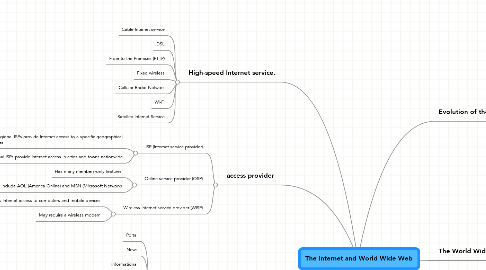The Internet and World Wide Web
da Witoon Keawnet


1. Evolution of the Internet
1.1. 1969 ARPANET becomes functional
1.2. 1984 ARPANET has more than 1,000 individual computers linked as hosts
1.3. 1986 NSF connects NSFnet to ARPANET and becomes known as the Internet
1.4. 1995 NSFNet terminates its network on the Internet and resumes status as research network
1.5. 1996 Internet2 is founded
1.6. Today More than 550 million hosts connect to the Internet
2. High-speed Internet service.
2.1. Cable Internet service
2.2. DSL
2.3. Fiber to the Premises (FTTP)
2.4. Fixed wireless
2.5. Cellular Radio Network
2.6. Wi-Fi
2.7. Satellite Internet Service
3. access provider
3.1. ISP (Internet service provider)
3.1.1. Regional ISPs provide Internet access to a specific geographical area
3.1.2. National ISPs provide Internet access in cities and towns nationwide
3.2. Online service provider (OSP)
3.2.1. Has many members-only features
3.2.2. Popular OSPs include AOL (America Online) and MSN (Microsoft Network)
3.3. Wireless Internet service provider (WISP)
3.3.1. Provides wireless Internet access to computers and mobile devices
3.3.2. May require a wireless modem
4. The World Wide Web
4.1. The World Wide Web, or Web, consists of a worldwide collection of electronic documents (Web pages)
4.2. A Web site is a collection of related Web pages and associated items
4.3. A Web server is a computer that delivers requested Web pages to your computer
4.4. Web 2.0 refers to Web sites that provide a means for users to interact
4.5. A Web browser, or browser, allows users to access Web pages and Web 2.0 programs
4.5.1. Internet Explorer
4.5.2. Firefox
4.5.3. Opera
4.5.4. Safari
4.5.5. Google Chrome
4.6. NewSome Web pages are designed specifically for microbrowsers node
4.6.1. A home page is the first page that a Web site displays
4.6.2. Web pages provide links to other related Web pages Surfing the Web
4.6.3. Downloading is the process of receiving information
